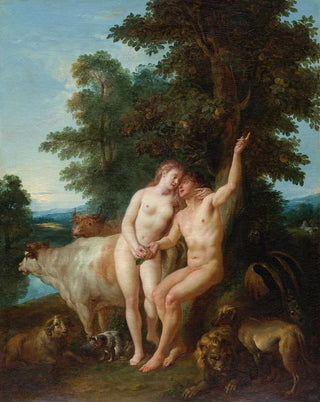Art print | Adam and Eve - Jean-François de Troy


View from behind

Frame (optional)
Adam and Eve - Jean-François de Troy – Captivating Introduction
The artwork "Adam and Eve" by Jean-François de Troy presents itself as a true ode to the beauty and complexity of the human condition. In this painting, the artist depicts the famous biblical couple at a pivotal moment in their existence, just before the fall, embodying the duality between innocence and knowledge. The figures of Adam and Eve, beautifully rendered, are immersed in a lush landscape, symbolizing both the Garden of Eden and the dawn of a new era for humanity. This representation, rich in detail and emotion, captivates the viewer, inviting reflection on universal themes of temptation, desire, and morality.
Style and uniqueness of the work
Jean-François de Troy's style is distinguished by its finesse and elegance. In "Adam and Eve," soft colors and delicate lighting create an almost dreamlike atmosphere, where the gaze is guided by harmonious curves and subtle expressions. The treatment of the bodies, both realistic and idealized, demonstrates impressive technical mastery, while highlighting the classical beauty of human figures. Every detail, from lush foliage to the flowing drapery of clothing, contributes to a balanced and serene composition. The artist manages to capture the very essence of his characters, expressing through their poses and gazes a psychological depth that transcends the simple biblical story. This work, both narrative and aesthetic, invites meditative contemplation, revealing the richness of human emotions.
The artist and his influence
Jean-François de Troy, an emblematic figure of the 18th century, is part of the lineage of great masters of French painting. Influenced by classicism and rococo, he succeeds in merging these styles to create a unique work, both refined and accessible. His ability to treat mythological and religious subjects with a humanist approach gives him a special place in art history. De Troy has established himself through his talent for representing beauty in all its forms, while incorporating narrative elements that speak to the soul. His influence is felt not only in

Matte finish

View from behind

Frame (optional)
Adam and Eve - Jean-François de Troy – Captivating Introduction
The artwork "Adam and Eve" by Jean-François de Troy presents itself as a true ode to the beauty and complexity of the human condition. In this painting, the artist depicts the famous biblical couple at a pivotal moment in their existence, just before the fall, embodying the duality between innocence and knowledge. The figures of Adam and Eve, beautifully rendered, are immersed in a lush landscape, symbolizing both the Garden of Eden and the dawn of a new era for humanity. This representation, rich in detail and emotion, captivates the viewer, inviting reflection on universal themes of temptation, desire, and morality.
Style and uniqueness of the work
Jean-François de Troy's style is distinguished by its finesse and elegance. In "Adam and Eve," soft colors and delicate lighting create an almost dreamlike atmosphere, where the gaze is guided by harmonious curves and subtle expressions. The treatment of the bodies, both realistic and idealized, demonstrates impressive technical mastery, while highlighting the classical beauty of human figures. Every detail, from lush foliage to the flowing drapery of clothing, contributes to a balanced and serene composition. The artist manages to capture the very essence of his characters, expressing through their poses and gazes a psychological depth that transcends the simple biblical story. This work, both narrative and aesthetic, invites meditative contemplation, revealing the richness of human emotions.
The artist and his influence
Jean-François de Troy, an emblematic figure of the 18th century, is part of the lineage of great masters of French painting. Influenced by classicism and rococo, he succeeds in merging these styles to create a unique work, both refined and accessible. His ability to treat mythological and religious subjects with a humanist approach gives him a special place in art history. De Troy has established himself through his talent for representing beauty in all its forms, while incorporating narrative elements that speak to the soul. His influence is felt not only in






